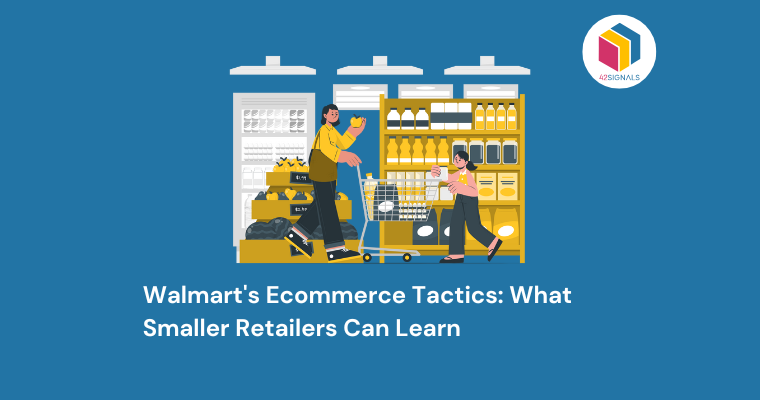In recent years, Walmart has made significant strides in ecommerce, becoming the second-largest ecommerce retailer in the United States behind Amazon. With ecommerce accounting for over 18% of Walmart’s total sales, smaller retailers can certainly learn a thing or two from the company’s tactics.
From omni-channel retailing to large investments in ecommerce and mobile commerce, Walmart has employed various strategies to drive growth and enhance customer satisfaction. However, it’s essential to acknowledge that not all attempts were successful, providing valuable insights into what to avoid.
Walmart’s Ecommerce Tactics
Omni-Channel Retailing

Image Source: CB Insights
One of the critical factors driving Walmart’s ecommerce success is its focus on omnichannel retailing. By allowing customers to browse products online before purchasing them in-store (click-and-collect) or delivering orders quickly through shipping networks like Walmart Grocery Pickup and Delivery, the company offers seamless integration between offline and online experiences. As a result, consumers benefit from greater convenience and flexibility when shopping, leading to higher levels of engagement and loyalty.
Large Investments in Ecommerce
To remain competitive against industry giants like Amazon, Walmart has invested heavily in ecommerce infrastructure, including fulfilment centers, distribution facilities, and delivery services.

Image Source: eCommerce Insights
These investments aim to streamline logistics, reduce turnaround times, and ensure faster deliveries while maintaining cost efficiency. Moreover, investing in cutting-edge technologies supports scalability, enabling businesses to cater to growing demands effectively.
Focus on Customer Satisfaction
A core component of Walmart’s ecommerce strategy revolves around enhancing customer experience. Through initiatives like free two-day shipping, price-matching guarantees, and effortless return policies, the company prioritizes customer satisfaction above short-term profits.

Image Source: Supermarket News
Additionally, tailored promotions based on individual preferences foster long-lasting relationships with clients, encouraging repeat purchases.
Supply Chain Innovations

Image Source: ResearchGate
Leveraging innovative solutions within supply chains enables companies to optimize inventory management and minimize operational expenses. Walmart has demonstrated this concept by integrating blockchain technology to track food items from farm to table, ensuring freshness and reducing waste. Furthermore, data analytics tools facilitate demand forecasting, empowering organizations to prepare adequately for seasonal fluctuations and maintain optimal stock levels.
Mobile Commerce
As smartphone adoption rates continue to rise, mobile devices have become crucial touchpoints along the consumer journey. Recognizing this trend, Walmart developed dedicated apps offering features such as mobile checkout, visual search capabilities, and augmented reality product browsing.

Image Source: Business Insider
Consequently, mobile transactions account for nearly three-quarters of Walmart’s digital sales during peak holiday seasons.
Learning from Failures
Despite its achievements, Walmart encountered setbacks throughout its ecommerce evolution. A notable example includes JetBlack, a same-day delivery service launched in 2018 targeting high-end urban markets. Despite initial excitement surrounding the venture, JetBlack struggled to achieve profitability due to low subscription conversion rates and exorbitant operating costs. Ultimately, Walmart discontinued the project in early 2021, absorbing some aspects of the platform into existing offerings.
Lessons for Small Retailers
Examining Walmart’s triumphs and tribulations reveals several actionable insights applicable to small retailers seeking to expand their ecommerce presence:
- Prioritize omni-channel retailing by merging brick-and-mortar locations with digital interfaces to provide consistent, convenient shopping experiences.
- Allocate resources towards strategic ecommerce investments aimed at improving backend infrastructure, logistics, and front-end functionalities.
- Adopt customer-centric approaches centered around user experience optimization, prompt support, and flexible pricing options.
- Implement innovations within supply chains to maximize efficiencies and minimize wastage.
- Embrace mobile commerce opportunities via responsive websites and feature-rich applications designed specifically for handheld devices.
- Understand that failure is inevitable and utilize lessons learned to inform future decisions and refine current practices.
Final Thoughts on Walmart’s Ecommerce Strategies
By exploring Walmart’s ecommerce tactics, retailers of varying sizes can identify best practices suitable for implementation within their unique contexts. Although challenges may arise, understanding consumer expectations, adapting swiftly to emerging trends, and remaining agile ultimately contribute to sustainable growth and lasting success.
To read more such informative articles, visit our blog or insights page.





